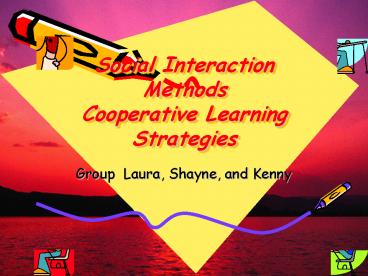Social Interaction Methods Cooperative Learning Strategies - PowerPoint PPT Presentation
1 / 16
Title:
Social Interaction Methods Cooperative Learning Strategies
Description:
... some sites to check out for clock ... you might want to check out. NTLF's Frequently Asked Questions ... Description of Procedure: Students are divided into ... – PowerPoint PPT presentation
Number of Views:49
Avg rating:3.0/5.0
Title: Social Interaction Methods Cooperative Learning Strategies
1
Social Interaction MethodsCooperative Learning
Strategies
- Group Laura, Shayne, and Kenny
2
What are Cooperative Learning Structures?
- Structures are very specific cooperative learning
strategies that teachers can use to organize
interactions between students. - Most structures can be used with almost any
academic content, but some structures are better
than others for certain tasks. - Some structures regulate interaction between
pairs, some are best for team work, and others
involve the entire class. - The key is learning which structure is
best-suited for a particular instructional
purpose.
3
What can you do with Cooperative Learning
Structures
- Clock Buddies
- Roundtable
- Six Thinking Hats
- Since you know the meaning of cooperative
learning structures, can you think of any others
that we didnt just mention?
4
Clock Buddies
- Definition
- A cooperative learning pairing model, based upon
the face of a clock. Students are paired with 12
different students for each hour on the clock.
Teachers may instruct students to work in groups
according to their clock buddy on a specific hour.
- Guidelines for Design
- Homogeneous Pairs
- The teacher may assign each child 12 clock
buddies and provide the completed handout. - Each hour may then correlate to a specific
content skill Reading 1 oclock, Math 2
oclock, English 3 oclock
5
Benefits
- Students can form partnerships quickly
- Students have the opportunity to work with
different partners - Prevents hurt feelings
- Students think its fun
- Heterogeneous Pairs
- Each student is given a clock handout.
- The student may then ask 12 classmates to be
his/her buddy for one of the hours on the clock.
- The student buddies must sign-up for the same
hour on each others handouts
6
Were you Listening?
- Can you name two benefits from using the clock
buddy approach? - Here are some sites to check out for clock
buddies. - Mrs. Atkinsons Reading Room www.westampton.k12.nj
.us/datkinson/clock_buddies.htm - Mrs. Thonus 3rd Grade Stars
- http//myschoolonline.com/page/0,1871,2486-196464-
2-55490,00.html - www.huffenglish.com
7
Roundtable
- Definition
- Cooperative learning strategy used to engage a
group of students in the initial analysis of a
teacher-posed question.
8
Description of Procedure
- Teacher poses a question that can be answered in
multiple ways. - Students are divided into small groups.
- One piece of paper and one pen given to each
group. - First student writes one response on paper AND
reads it aloud to group.
- First student then passes paper to the next
student on his/her left. - This student may write a response or say Pass.
- The paper is then passed to all the students
until time is called. - Groups may discuss responses or share with large
group.
9
Benefits
- Each students response is valued equally
- All students have an opportunity to contribute
ideas - Promotes ability to brainstorm, generate
questions, and provide creative answers
10
Can anyone name any other benefits on the
roundtable that we might not of talked about?A
place you might want to check out.NTLFs
Frequently Asked Questions (FAQ)www.ntlf.com/html
/lib/faq/cl-utenn.htm
11
Six Thinking Hats
- Definition
- Cooperative learning role-play strategy used to
help students respect and explore a variety of
perspectives regarding a decision-making process.
12
Description of Procedure
- Students are divided into groups of six.
- Each student in the group is then assigned one of
the six colored hats, which represents a specific
perspective they will adopt while participating
in the group activity. - Teacher may provide brief description and/or
appropriate questions for each hat. - The group then analyses and discusses the group
activity by responding not as themselves, but as
the perspective/identity of the hat each is
wearing.
13
The Six Hats
- White Neutral , focus on information,
objective, FACTS - Red Fire, focus on intuition, subjective,
FEELINGS - Black Judges robe, focus on the negative,
JUDGEMENTAL - Yellow Sunshine, focus on positive, STRENGTHS
- Green Vegetation, focus on possibilities,
CREATIVE - Blue Cool, focus on process, THINKING
14
Benefits
- Multiple perspectives are realized and valued
- Students participate without risk of personal
opinions - Engaged in multilayered thinking processes
- Improve communication skills
- Improve decision-making skills
15
What color hat would you like to wear, and
why?More information about your
hats.www.valuebasedmanagement.net/methods_bono_si
x_thinking_hats.html
16
Benefits of cooperative learning strategies
- Allows students to work with different partners
(socially beneficial) - All student have the ability to contribute ideas
- Promotes students ability to brainstorm and
generate questions































